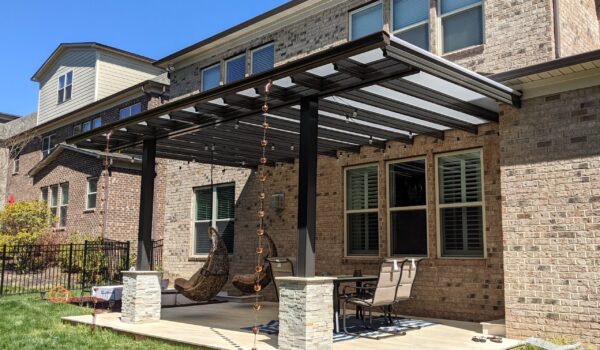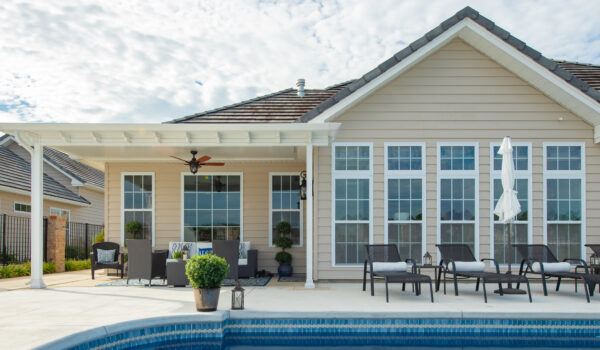Installing an attached or freestanding patio is one of the most common ways to extend the outdoor season and add a lifetime of value to your home. Renaissance Patio has supplied the sturdy, beautiful aluminum components for thousands of patio covers, pergolas, gazebos, and other outdoor living spaces. We understand the process and every aspect of construction. Like any home improvement project, building an outdoor room addition requires a bit of planning and compliance with a variety of rules and regulations.
Patio covers represent an important part of residential life. There are few laws that prohibit patio roofs, no matter the type of house or its location. As long as you own your single-family home you can have a patio.
There are, however, a few codes and regulations that municipalities put in place to ensure compliance with workmanship quality, safety guidelines, and community standards.

HOA Approval
If you live in a neighborhood with a homeowners association (HOA), there’s a good chance that a big section of its book of covenants, conditions, and restrictions (CC&Rs) will be devoted to patio covers and other yard structures. CC&Rs are designed to protect residents from having their views restricted, their sensibilities offended, or their quality of life diminished by unneighborly neighbors. That includes weird paint jobs, unkempt lawns, and overzealous building projects. CC&Rs will detail what you can and cannot do to your home and property. They keep things from becoming outrageous, but they allow most conventional patio designs.
Your HOA probably will appoint a committee to ensure residents uphold the CCR’s. You will submit a patio application to the committee, along with drawings, specifications, and building plan, color scheme, construction materials, etc. In most cases, this is a mere formality and the committee will issue its approval within 30, 45, or 60 days. Make note of the timeframe so the process does not hold up your project. Do not skip this step. It’s not worth picking a fight with your HOA, and if its approval is required, your city or county will not issue your building permit until it is done.
State and Local Regulations
Speaking of building permits, most jurisdictions require one before installation of your patio cover or other structure can begin. Like your HOA application, the building permit will spell out what your patio will look like – size, shape, materials – as well as the steps the contractor will take to conform to applicable building and safety codes. Your licensed contractor can complete the permit application. In fact, in many jurisdictions only licensed contractors and owner/builders are allowed to pull permits. No reputable contractor will skip this step. Getting caught will incur a hefty fine and possibly a license suspension or revocation. You could be forced to tear down your structure, apply for a permit, then rebuild, expenses you do not want. Even if you “get away with” building without a permit, the transgression will come to light if you try to sell your home. You can find permit forms and guidelines online. Follow the rules promulgated by your most local jurisdiction. If you live within the city limits, the city’s building department – not the county’s or state’s – will issue the permit and its building code applies.
Building and Zoning Codes
Complying with building codes is the contractor’s responsibility, but you might want to familiarize yourself with them so you can effectively oversee the project and understand why your builder does things a certain way. Codes are developed by national and international committees to ensure sound, safe structures. Local building departments can amend the rules to address certain conditions. For instance, San Francisco’s earthquake codes are more comprehensive than Boston’s. Other local amendments may cover soil conditions, drainage, etc.
Zoning regulations normally don’t apply to pergolas because it’s not a “solid” roof, most municipalities are lenient. For patio covers and patio roofs “solid roofs,” they are more restrictive especially as it approaches your property line where it could interfere with easements or approaches to public streets or utility access.
Logistics
Wading through the paper trail and cutting through the red tape involves a bit of work. You and your contractor also need to address logistical and site challenges to make your outdoor space your favorite room of the house. Consider your current and planned landscape, yard shape and dimensions, and patio location in drawing up your plans. Think about how you will use your new space. Will you install an outdoor kitchen? Need lots of furniture? Want easy access to the pool or garden? Designing your space around these desires is part of the fun of building a patio. Work with your contractor to decide how to highlight your yard’s features and focal points while making space accessible, functional, and attractive. Any home’s appearance, liveable space, and resale value can be improved with a freestanding or attached patio room addition. And any space can be molded to accommodate an outdoor living structure. Contact Renaissance Patio today and we will put you in touch with a local, authorized installer who will work with you to design, schedule, and install the backyard living space you have always dreamed of.



